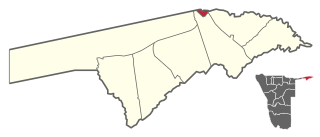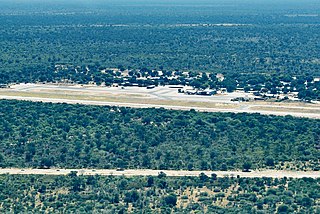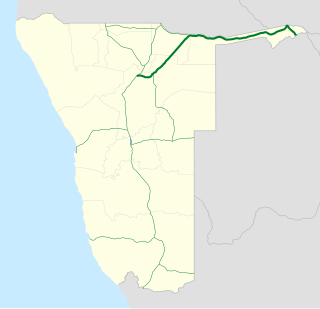
The Zambezi Region is one of Namibia's fourteen regions, situated in the north-eastern part of the country along the Zambezi River where it gets it's name from. The region's capital is the town of Katima Mulilo. The Katima Mulilo Airport is 18 kilometres south-west of the town, while the village of Bukalo is located 43 kilometres south-east of Katima Mulilo. Formerly known as the Caprivi Region until 2013, it has eight electoral constituencies and a population of 142,373 according to the 2023 census.

Katima Mulilo UrbanConstituency is an electoral district in Namibia. It is situated in the Zambezi Region. The region's capital, Katima Mulilo, is in this constituency. The constituency has a population of 28,362 people. In the 2020 Regional Council Elections, there were 13,860 registered voters.

Katima Mulilo Rural is a constituency in the Zambezi Region of Namibia. It comprises the area south of the town of Katima Mulilo, the regional capital. As of 2020, the constituency had 6,712 registered voters.

Katima Mulilo or simply Katima is the capital of the Zambezi Region in Namibia. It had 46,401 inhabitants in 2023, and comprises two electoral constituencies, Katima Mulilo Rural and Katima Mulilo Urban. It is located on the B8 national road on the banks of the Zambezi River in the Caprivi Strip in lush riverine vegetation with tropical birds and monkeys. The town receives annual average rainfall of 654 millimetres (25.7 in).

Sesheke is a border town in the Western Province of Zambia, in a district of the same name. It lies on the northern bank of the Zambezi River which forms the border with Namibia's Caprivi Strip at that point.

The Walvis Bay-Ndola-Lubumbashi Development Road runs from Walvis Bay, through Rundu in north eastern Namibia, along the Caprivi Strip to Katima Mulilo on the Zambezi River, which forms the border between Namibia and Zambia. The Katima Mulilo Bridge spans the river to the Zambian town of Sesheke from where a road runs to Livingstone, joining the main north–south highway to Lusaka, connecting onwards to the Copperbelt.
Sibbinda is a settlement in the Zambezi Region of north-eastern Namibia. Situated 64 kilometres south-west of the region's capital, Katima Mulilo, it serves as the administrative centre of the Sibbinda Constituency.

The Katima Mulilo Bridge carries the TransCaprivi Highway over the Zambezi River between Katima Mulilo, Namibia and Sesheke, Zambia. It is a road bridge, completed in 2004, 900 metres long and with 19 spans. It links Namibia's Trans–Caprivi Highway to the Zambian road network, forming a section of the trade route from south-central Africa to the Atlantic known as the Walvis Bay Corridor. It also carries tourist traffic.

Luhonono is a settlement in the Zambezi Region of northeastern Namibia. It is part of the Kabbe North electoral constituency. Formerly known as Schuckmannsburg, it served as the capital of the area now known as the Zambezi Region during the era of German colonialism.

Bukalo is a village in Namibia. It lies in the Zambezi Region 43 kilometres from the region’s capital, Katima Mulilo. It is also the Royal Headquarters of the Subia people. In 2013, it was upgraded from a settlement to a village with its own village council by the former President of Namibia, Hifikepunye Pohamba.

Katima Mulilo Airport, also known as Mpacha Airport, serves Katima Mulilo, the capital of the Zambezi Region in Namibia. The airport is on the B8 road, about 18 km (11 mi) southwest of Katima Mulilo. The Katima Mulilo non-directional beacon is located on the field.

The Kazungula Ferry was a pontoon ferry across the 400-metre-wide (1,300 ft) Zambezi River between Botswana and Zambia. It was one of the largest ferries in south-central Africa, having a capacity of 70 tonnes. The service was provided by two motorised pontoons and operated between border posts at Kazungula, Zambia and Kazungula, Botswana.

B8 road often known as the Golden Highway is one of the national highways of Namibia. It leads from the B1 at Otavi via Grootfontein and Rundu through the Caprivi Strip to the border town of Katima Mulilo and further on to the Botswana border at Ngoma. The section from Otavi to Katima Mulilo forms part of the Walvis Bay-Ndola-Lubumbashi Development Road.

Namibia–Zambia relations refers to the bilateral relations of Namibia and Zambia. Namibia and Zambia are separated by the Zambezi River. The Katima Mulilo Bridge connects Katima Mulilo on the Namibia side with Sesheke, Zambia. Both countries are members of the African Union and Non-Aligned Movement.
Richard Kapelwa Kabajani was a Namibian activist, militant, diplomat and politician. Kabajani was a military commander for SWAPO during the Namibian War of Independence and after independence served a minister in the Namibian government.
Ibbu is a settlement in Namibia's Zambezi Region, located 80 kilometres southeast of the region's capital, Katima Mulilo. It falls under the Katima Rural Constituency and has its own medical facility, Ibbu Clinic.
Sangwali is a settlement in the Zambezi Region of north-eastern Namibia. Situated 130 kilometres south-west of the region's capital, Katima Mulilo, it serves as the administrative centre of the Judea Lyaboloma Constituency. Sangwali is the Royal Headquarters of the Yeyi people.
The M10 road is a road in Zambia. It goes from Livingstone, through Sesheke and Senanga, to Mongu. The road is approximately 508 kilometres and follows the Zambezi River for its entire length.
Choto is an informal settlement in Katima Mulilo in northern Namibia. As of the 2010 census, it has a population of about 11,200.














